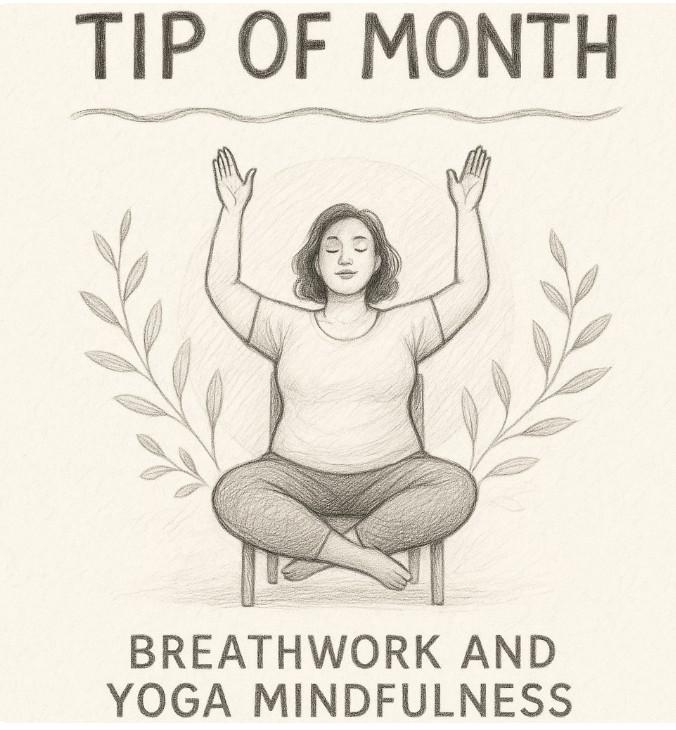Yoga Tip of the Month – May: Unlocking the Power of the Breath (Pranayama)
When most people think of yoga, they envision flowing postures and stretchy bodies. But at the core of every yoga practice lies a far more subtle and powerful tool: the breath. This month, we’ll focus on Pranayama — the art and science of yogic breathing — and how you can integrate it into your daily life to transform your practice and well-being.
What is Pranayama?
“Prana” means life force or vital energy, and “ayama” means to extend or control. Pranayama is the practice of consciously regulating the breath in order to influence the flow of prana in the body. In yogic philosophy, prana is the force that sustains all life. Through the breath, we can regulate our nervous system, quiet the mind, and reconnect to our center.
In traditional yoga, pranayama is considered just as important—if not more important—than asana (physical postures). While movement prepares the body, it’s the breath that truly opens the door to deeper awareness and transformation.
Why Focus on the Breath?
The breath is the only autonomic function of the body that we can also control consciously. That makes it a powerful bridge between the body and the mind. Here’s what focused breathing can do:
- Calm the nervous system: Deep breathing activates the parasympathetic (rest-and-digest) nervous system, reducing stress and anxiety.
- Improve oxygenation: Efficient breathing enhances oxygen delivery to tissues and removes carbon dioxide more effectively.
- Sharpen mental focus: Slower, intentional breathing reduces mental chatter and helps you concentrate.
- Increase emotional regulation: Awareness of the breath increases mindfulness, helping you respond rather than react.
Foundational Breathing Practices for All Levels
You don’t need to be an advanced yogi to begin pranayama. Here are three simple and effective techniques to start with:
1. Three-Part Breath (Dirga Pranayama)
When to use: Anytime you feel stressed or disconnected.
How to practice:
- Sit or lie down in a comfortable position. Place one hand on your belly and one on your chest.
- Inhale slowly through your nose, first filling the belly, then the ribs, then the chest.
- Exhale slowly in reverse: release air from the chest, then the ribs, and finally the belly.
- Repeat for 5-10 cycles.
Benefits: Grounding, calming, improves lung capacity, teaches breath awareness.
2. Box Breathing (Sama Vritti Pranayama)
When to use: During anxious moments, before meetings, or to center yourself.
How to practice:
- Inhale for a count of 4
- Hold the breath for 4
- Exhale for a count of 4
- Hold again for 4
- Repeat for several rounds, adjusting the count if needed.
Benefits: Enhances focus, reduces anxiety, balances the breath.
3. Alternate Nostril Breathing (Nadi Shodhana)
When to use: To prepare for meditation, sleep, or to balance energy.
How to practice:
- Sit in a comfortable seat. Use your right thumb to close your right nostril.
- Inhale through the left nostril.
- Close the left nostril with your ring finger, release the right, and exhale through the right nostril.
- Inhale through the right nostril, then switch and exhale through the left.
- Continue alternating for 5–10 minutes.
Benefits: Balances the left and right brain hemispheres, calms the mind, prepares the body for meditation.
Common Mistakes and Tips
- Forcing the breath: Breath should be smooth, steady, and without strain. Avoid trying to push or control the breath aggressively.
- Holding tension: Keep the body relaxed, especially the face, shoulders, and jaw.
- Inconsistency: Like any habit, breathwork benefits from regularity. Even 5 minutes a day can make a difference.
How to Integrate Pranayama Into Your Daily Life
- Morning Reset: Start the day with 5 minutes of Three-Part Breath to ground yourself.
- Midday Mindfulness: Practice Box Breathing at your desk to refocus and reset.
- Evening Wind-down: Use Nadi Shodhana before bed to release the day and prepare for restful sleep.
These mini rituals can help you carry the calm of yoga off the mat and into your daily experiences.
Real-World Application: Pranayama for Pain and Fatigue
Many students I work with live with chronic pain, fatigue, or limited mobility. For them, even gentle movement can be too much some days. On those days, breathwork becomes the practice.
Breath awareness can shift your nervous system out of survival mode and into a state where healing is possible. It’s not about “doing” more — it’s about being more present with what is. The breath invites us to accept our bodies, sensations, and limitations with kindness. That’s yoga in its purest form.
A Final Word: Let the Breath Be Your Guide
This May, allow your breath to become your teacher. Let it lead you gently inward — not to some idealized version of yourself, but to the truth of where you are, right now.
Whether you're practicing in a studio, a chair, or lying on your back with your eyes closed, the breath will meet you there. It will carry you into presence. Into healing. Into connection.
Because yoga isn’t about flexibility — it’s about relationship.
And your breath is the most faithful companion on that journey.

